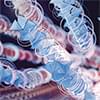More people than we thought who are in comas or similar states can hear what is happening around them, a study shows.


Bacteria defend themselves from viral infection using diverse immune systems, many of which sense and target foreign nucleic acids. Defense-associated reverse transcriptase (DRT) systems provide an intriguing counterpoint to this immune strategy by instead leveraging DNA synthesis, but the identities and functions of their DNA products remain largely unknown. Here we show that DRT2 systems execute an unprecedented immunity mechanism that involves de novo gene synthesis via rolling-circle reverse transcription of a non-coding RNA (ncRNA). Unbiased profiling of RT-associated RNA and DNA ligands in DRT2-expressing cells revealed that reverse transcription generates concatenated cDNA repeats through programmed template jumping on the ncRNA. The presence of phage then triggers second-strand cDNA synthesis, leading to the production of long double-stranded DNA. Remarkably, this DNA product is efficiently transcribed, generating messenger RNAs that encode a stop codon-less, never-ending ORF (neo) whose translation causes potent growth arrest. Phylogenetic analyses and screening of diverse DRT2 homologs further revealed broad conservation of rolling-circle reverse transcription and Neo protein function. Our work highlights an elegant expansion of genome coding potential through RNA-templated gene creation, and challenges conventional paradigms of genetic information encoded along the one-dimensional axis of genomic DNA.
One-Sentence Summary Bacterial reverse transcriptases synthesize extrachromosomal genes via rolling-circle amplification to confer potent antiviral immunity.
Columbia University has filed a patent application related to this work. S.H.S. is a co-founder and scientific advisor to Dahlia Biosciences, a scientific advisor to CrisprBits and Prime Medicine, and an equity holder in Dahlia Biosciences and CrisprBits.

University of California, Irvine scientists recently discovered a one-dimensional nanoscale material whose color changes as temperature changes. The team’s results appeared in Advanced Materials (“Sensitive Thermochromic Behavior of InSeI, a Highly Anisotropic and Tubular 1D van der Waals Crystal”).
“We found that we can make really small and sensitive thermometers,” said Maxx Arguilla, UC Irvine professor of chemistry whose research group led the study. “It’s one of the most applied and translatable works to come out of our lab.”
Arguilla likened the thermometers to “nanoscale mood rings,” referring to the jewelry that changes color depending on the wearer’s body temperature. But instead of simply taking a qualitative temperature reading, the changes in the color of these materials “can be calibrated and used to optically take temperature readings at the nanoscale,” Arguilla said.
Philosopher and cognitive scientist David Chalmers explores virtual reality and its implication for our understanding of existence. Chalmers examines the simulation hypothesis, challenging conventional views of reality and suggesting that virtual worlds might be as real and meaningful as the physical world. This is a thought-provoking lecture at MindFest, held at Florida Atlantic University, CENTER FOR THE FUTURE MIND, spearheaded by Susan Schneider.
TIMESTAMPS:
00:00 — Intro.
01:34 — Overview.
11:55 — David’s Central Thesis.
15:55 — Biosim vs. Pure Sim.
18:11 — Imperfect vs. Perfect Simulation.
26:38 — Are Simulations Illusions?
31:29 — It-From-Bit Hypothesis.
36:06 — What Is The Metaverse?
43:58 — Meaning In A Virtual World.
51:49 — Q\&A
01:06:43 — Outro.
NOTE: The perspectives expressed by guests don’t necessarily mirror my own. There’s a versicolored arrangement of people on TOE, each harboring distinct viewpoints, as part of my endeavor to understand the perspectives that exist.
THANK YOU: To Mike Duffey for your insight, help, and recommendations on this channel.
Support TOE:
- Patreon: / curtjaimungal (early access to ad-free audio episodes!)
- Crypto: https://tinyurl.com/cryptoTOE
- PayPal: https://tinyurl.com/paypalTOE
- TOE Merch: https://tinyurl.com/TOEmerch.
Follow TOE:

A University of Portsmouth physicist has explored whether a new law of physics could support the much-debated theory that we are simply characters in an advanced virtual world.
The simulated universe hypothesis proposes that what humans experience is actually an artificial reality, much like a computer simulation, in which they themselves are constructs.
The theory is popular among a number of well-known figures including Elon Musk, and within a branch of science known as information physics, which suggests physical reality is fundamentally made up of bits of information.



“This breakthrough helps us better understand and study the fascinating world of quantum physics,” he says.
The fluorescent nanodiamonds, with an average diameter of about 750 nm, were produced through high-pressure, high-temperature synthesis. These diamonds were irradiated with high-energy electrons to create nitrogen-vacancy color centers, which host electron spin qubits.
When illuminated by a green laser, they emitted red light, which was used to read out their electron spin states. An additional infrared laser was shone at the levitated nanodiamond to monitor its rotation. Like a disco ball, as the nanodiamond rotated, the direction of the scattered infrared light changed, carrying the rotation information of the nanodiamond.

In the quest to unravel the complexities of neural circuits, scientists are beginning to use genetically encoded voltage indicators (GEVIs) to visualize electrical activity in the brain. These indicators are crucial for understanding how neurons communicate and process information. However, the effectiveness of one-photon (1P) versus two-photon (2P) voltage imaging has remained a topic of debate. A recent study by researchers at Harvard University sheds light on the relative merits and limitations of these two imaging techniques, providing valuable insights for the scientific community.

Vortex rings, a mysterious and fascinating natural phenomenon, display breathtaking structures and behaviors in both air and electromagnetic waves. Imagine an air cannon that can shoot vortex rings, creating a perfect air vortex that travels gracefully through the air as if an invisible hand is sketching an elegant curve in the sky. This vortex phenomenon is not just a spectacle of physics but a masterpiece of nature.